8 Medicinal Plants the Native Americans Used for Survival – Survivopedia

When modern medicine is out of reach, the knowledge of wild medicinal plants can mean the difference between life and death. Native American peoples survived for millennia using the healing gifts of the land – a wisdom born of necessity and deep respect for nature. Imagine facing a fever or a deep cut days away from any hospital; the lack of access to modern medicine becomes a dire problem. Native tribes learned to solve that problem with powerful medicinal plants, handed down through generations. In this article, we’ll explore eight North American plants that indigenous tribes used for survival. Each plant is still common today and offers practical off-grid remedies – from teas and poultices to tinctures.

You’ll discover which tribe used each plant and for what purpose, how to identify it in the wild, how to use it safely for survival, and important warnings (such as pregnancy risks or poisonous lookalikes) to keep in mind. These short, focused sections will give you a logical, skimmable guide to nature’s pharmacy – a life-saving wisdom we’d all do well to remember.
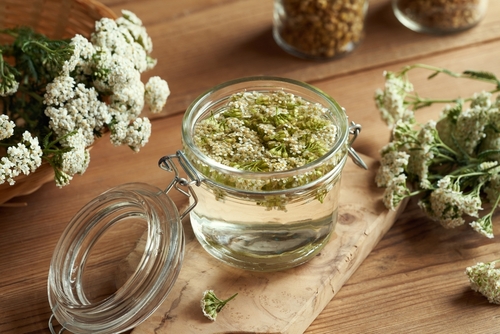
Yarrow – The First Aid “Life Medicine”
Yarrow (Achillea millefolium) was so valued by indigenous peoples that the Navajo called it “life medicine”. Many tribes across North America relied on yarrow for its remarkable ability to stop bleeding and fight infection in wounds. The Pawnee would chew yarrow stalks for pain relief, and the Cherokee drank yarrow tea to reduce fevers and induce restful sleep.1 Frontier pioneers learned from Native healers to pound the feathery leaves into a poultice for open cuts – its astringent compounds help blood clot fast.2
Yarrow teas were also taken for stomach aches, to reduce fever by promoting a sweat, and even to ease joint pain.3 In a survival situation, yarrow is like a natural first aid kit: you can apply its crushed leaves to a wound to disinfect and stanch bleeding, or brew a bitter tea to help fevers and digestive issues.4
Identification:
Yarrow is a hardy wildflower found in meadows, grasslands, and along disturbed soils throughout North America. It’s easy to spot once you know it: look for soft, fern-like leaves that are finely divided into many tiny leaflets (giving it the nickname “thousand-seal” or “milfoil”). In summer, yarrow sends up stalks topped with flat clusters of small flowers, usually white (though domesticated yarrows may be yellow, pink, or red). The wild white yarrow is considered the most potent medicinally.5 The plant often stands 1–2 feet tall. Crush a leaf – it has a strong medicinal, almost sage-like aroma. Yarrow is widespread in temperate regions; if you find wild daisies and black-eyed Susans, there’s a good chance yarrow might be nearby as well.
Warnings:
Yarrow is generally safe in moderate use, but there are a few cautions. Pregnant women should avoid using yarrow, as it was traditionally used to stimulate menstruation and could potentially cause miscarriage.6 Also, some people are sensitive or allergic – handling yarrow can cause skin rash in susceptible individuals, especially those allergic to plants in the daisy/ragweed family. If you notice redness or irritation, discontinue use.7 As with any wild plant, make sure you’ve identified it correctly. Fortunately, yarrow’s unique leaves make it hard to confuse with poisonous plants (it somewhat resembles wild carrot or Queen Anne’s lace flowers, but those have umbrella-shaped flower clusters and very different leaves). When in doubt, skip it. Used wisely, yarrow can be a survivor’s best friend for wound care and more – a true gift from Mother Earth used for centuries.
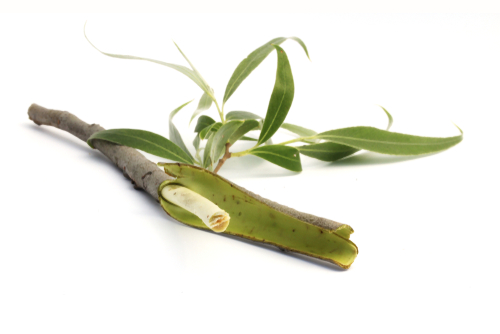
Willow – Nature’s Aspirin Pain Reliever
For countless generations, Native Americans soothed their aches and pains by turning to the willow tree, a remedy so effective it led to the invention of aspirin.8 Tribes such as the Cherokee, Blackfoot, and Iroquois would brew a tea from willow bark to relieve headaches, fever, arthritis and general soreness.9 The Choctaw and Delaware even used chewed willow twigs as a sort of toothbrush – not only did it clean teeth, but the bark’s tannins kept gums healthy.10 Salicin, the compound in willow that eases pain and inflammation, is the natural forerunner of aspirin.8 Native healers knew that a simple decoction of willow bark could reduce a fever and take the edge off a severe toothache or backache. In a survival scenario, willow is the go-to for pain relief: if you’ve sprained an ankle or have a pounding headache, sipping on willow bark tea might dull the pain enough to keep you going. Early American settlers learned this the grateful way – by adopting the Native practice of willow medicine, which in 1897 was refined into aspirin, now the world’s most widely used drug.8
Identification:
Willows love water, so look for them along creek banks, lake shores, and wetlands across North America. They are deciduous trees or shrubs with long, slender, flexible branches. The leaves are usually narrow, lance-shaped with fine serrated edges, and often a glossy green. In spring, willows have small flowers arranged in fuzzy catkins. There are many species (black willow, white willow, weeping willow, etc.), but as a rule if you find a tree with willow’s trademark narrow leaves and damp habitat, you’ve likely got the right tree. The bark is grey or brown and can be peeled in long strips from younger branches. Harvest the inner bark (the greenish layer just under the tough outer bark) for medicine – that’s where the salicin content is highest. Always be sure of your tree ID: a helpful clue is that willows and poplars are in the same family; if it resembles a cottonwood or aspen leaf but much longer and thinner, it’s probably a willow.
Warnings:
Willow’s effects are real medicine – which means there are real precautions. Do not give willow bark to children or teenagers with viral illnesses, due to the risk of Reye’s syndrome, a serious reaction (the same warning that applies to aspirin).11 12 Anyone allergic to aspirin (salicylate allergy) should likewise avoid willow bark, as the salicin could trigger a similar allergic reaction.13 If you have a sensitive stomach or ulcers, use caution: willow can cause stomach upset or gastric bleeding in large doses or with long-term use.14 15 Pregnant or nursing women are usually advised to avoid salicylates, including willow, as these compounds can cross the placenta and affect the baby.16 Finally, remember that while willow can reduce pain and fever, it’s not a cure-all – seek medical help for serious infections or if symptoms persist. Treat willow with the respect due any strong medicine. Used appropriately, it can be a tremendous natural ally for pain management in the wild.
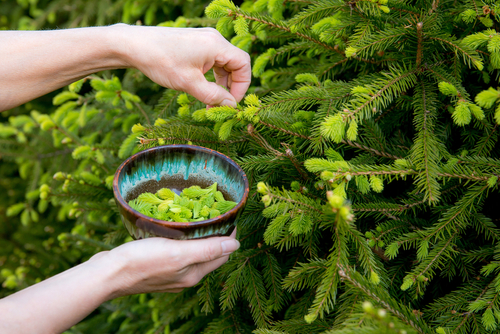
Pine (Evergreen Needles) – The Vitamin C Survival Tea
When European explorers were dying of scurvy in the 1500s, Native Americans revealed a simple cure: tea from evergreen needles. The Iroquois taught Jacques Cartier’s men to brew tea from spruce/pine needles, curing their scurvy with a megadose of vitamin C. Ever since, pine needle tea has been a known lifesaver during long winters. Several tribes also used pine for respiratory ailments – the Cherokee, for example, drank pine needle infusions for coughs and chest congestion (and gave the colonists white pine to treat colds and scurvy).17 12 The Eastern White Pine was even nicknamed the “Tree of Peace” and “Tree of Life” by some tribes, in part because of its healing powers. In survival situations, pine needles are an abundant source of Vitamin C (five times an orange by weight!). A warm cup of pine needle tea not only lifts morale but can prevent or treat scurvy, boost your immunity, and help clear up mucus when you’re battling a cold. You can also use sticky pine resin as a topical antiseptic and wound sealant – many indigenous peoples would pack pitch into wounds to ward off infection. When you’re lost or off-grid in a conifer forest, that stand of pines might just save your life by nourishing you and keeping illness at bay.
Making pine needle tea over a camp stove in the wild. Boiling a handful of fresh green pine needles in water for about 10 minutes releases a tangy, green tea rich in vitamin C and antioxidants. Sip slowly and breathe in the pine vapors to relieve congestion. (Avoid boiling too long, which can break down vitamin C.) This pine tea can be sweetened with a bit of pine sap or honey if available, though survivalists often just drink it straight.
Identification:
Pines, spruces, and firs are all evergreen conifers – any of them can work for needle tea, but true pines (genus Pinus) are often preferred. To identify a pine tree, look at how the needles grow: pine needles are arranged in clusters (bundles) of 2-5 needles, and each needle is usually long and flexible. Spruces and firs, on the other hand, have single needles attached individually to the branch. For example, Eastern White Pine has bundles of five slender, bluish-green needles (a handy mnemonic: W-H-I-T-E has five letters); by contrast, a spruce like Colorado Blue Spruce has sharp single needles that roll easily between your fingers. In an emergency, most evergreen needles from pines, spruces, and firs are safe to make tea, but do not use any species of yew (genus Taxus) – yew is a poisonous evergreen (needles are flat and dark green, with red berry-like cones) and not a true pine. A key difference: poisonous yew has red fleshy berries, whereas edible pines/spruces have dry cones and typically resinous scent. Also, avoid Norfolk Island pine and Ponderosa pine if you can identify them, as there are reports they may be harmful to pregnant livestock (so to be ultra safe, pregnant women should avoid pine needle tea altogether). When harvesting, choose younger, bright green needles if possible – they have the best flavor and nutrient content.
Warnings:
Pine needle tea is generally gentle, but there are still a few cautions. As mentioned, pregnant women should avoid drinking pine or spruce needle tea, because certain compounds (in some pines, like Ponderosa) have been linked to miscarriage in animals. Always positively identify the tree to avoid accidentally grabbing a toxic lookalike like yew. If you have allergies to evergreens (pine pollen is a common allergen), start with a small dose to see if you react. And like any strong tea, too much can cause nausea – pine needles contain tannins and resins that in large quantity might upset your stomach. Use a reasonable amount (a tablespoon of chopped needles per cup) and don’t ingest large quantities of pine resin (pitch), as it’s hard for the stomach to handle. Finally, remember vitamin C degrades with heat – steep, don’t violently boil, your needle tea to preserve nutrients. With these common-sense precautions, pine needle tea is a safe, refreshing survival drink that can keep scurvy and colds at bay when you’re living off the land.
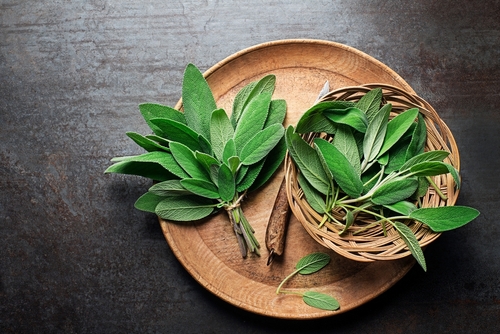
Sage (White Sage and Sagebrush) – Sacred Cleansing and Medicine
Sage is more than a seasoning – for Native Americans, sage is a sacred healer of both body and spirit. Across the deserts and plains, different species of sage have been used as antimicrobial medicine, smudging herbs, and even women’s health aids. In the Southwest, White Sage (Salvia apiana) is prized by the Cahuilla and other California tribes for treating colds, flu symptoms, sinus infections, and even toothaches. They brew a strong sage tea or inhale the aromatic smoke in sweat lodges, believing it purifies the respiratory system.19 20 The Dakota and Cheyenne made sage tea for stomach troubles and colds.21 Meanwhile on the Great Plains, Prairie Sage (Artemisia ludoviciana) (a sagebrush variety) was used by the Lakota and other Sioux peoples as an all-purpose remedy and purifier.22 They applied sage poultices to skin rashes and wounds, drank it to lower blood sugar, and burned it to ward off insects and negative energy.19 Many tribes regard sage smoke as a spiritual cleanser – hence “smudging” with sage bundles to cleanse a space or person of bad spirits or illness. In survival terms, sage can be a powerful antiseptic and decongestant: a wash or compress of sage can help disinfect cuts (thanks to its natural antimicrobial oils), and sipping sage tea can dry up mucus in a head cold or soothe a sore throat. Sage’s strong aroma even acts as a natural insect repellent – a few crushed sage leaves rubbed on the skin can help keep mosquitoes away. Little wonder sage was considered a “medicine cabinet” plant among indigenous people.
Identification:
Sage comes in many forms, but the wild sages used by Native Americans generally fall into two groups: true sages (Salvia species) and sagebrush (Artemisia species). White Sage (Salvia apiana) is an evergreen perennial shrub native to southern California and Baja, found on dry slopes and scrublands. It grows ~2–3 feet tall with silvery gray-green leaves that are long, velvety, and release a powerfully pungent, herbal scent when crushed. In summer it sends up white flower spikes beloved by bees. If you brush against white sage, you’ll often smell it before you see it. Prairie Sage / Sagebrush (Artemisia ludoviciana) grows across the Great Plains and West; it’s a low gray-green plant with narrower leaves that can have a camphor-like smell. Artemisia leaves are often deeply divided and may look a bit like a ragged feather. Both types of sage thrive in dry, open areas. A good rule: any strongly aromatic gray-green shrub in arid regions could be a sage or sagebrush. They are easily recognizable once introduced – as one Native author wrote, “Once one has been introduced to it, sage varieties are easily recognizable… One can smell them growing wild in the fields.”.23 Season: Most sages can be harvested year-round (the leaves are often evergreen or persist into winter). The best time for medicinal potency is usually summer when volatile oils are strongest.
Warnings:
Sage is potent, so a little goes a long way. Pregnant women should avoid medicinal doses of sage, as some varieties (especially Artemisia sages) were traditionally used to induce miscarriage or stimulate menstrual flow. In fact, some tribes refer to certain sagebrush as “women’s sage” for its use in women’s medicine (and its potential to affect pregnancy).24 Breastfeeding mothers should also be cautious – sage tea is known to dry up milk production (it was used when weaning babies).25 If you’re using sage internally, do so for short periods; long-term heavy use could lead to thujone buildup (a compound in some sages that can be toxic to the nervous system in high doses). Signs of overuse would be dizziness or rapid heartbeat – if that happens, discontinue use. Another concern today is sustainability: wild white sage has been over-harvested in some areas due to commercial demand.26 27 If you find it, harvest respectfully (never pull up the root; take only what you need and leave plenty to regrow).28 As a survivor, you want to preserve these plants for the future. Lastly, note that sage’s intense aroma can be overwhelming – use moderate amounts in teas to avoid nausea. Treated with respect, sage can purify your body and camp, fend off illness, and even lift your spirits in hard times, just as it has done for Native peoples for ages.
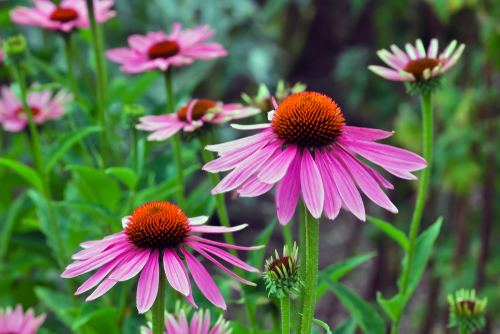
Echinacea – Prairie Immune Booster and Wound Medicine
When it comes to all-around healing, few plants rival Echinacea, the purple coneflower. Native to the Great Plains, Echinacea angustifolia was “the most widely used medicinal plant of the Plains Indians”.29 At least 15 tribes, including the Lakota, Cheyenne, Kiowa, Crow, and Ponca, used echinacea for a huge range of ailments: coughs, colds, sore throats, toothaches, infections, and even snake bites.30 The Lakota word for it translates to “something used to knock something down,” hinting at its infection-fighting power.31 The Cheyenne would chew pieces of echinacea root and let the juice trickle down the throat to cure sore throats and tonsillitis. They also brewed echinacea tea to relieve rheumatism, mumps, and measles.32 The Crow tribe believed echinacea had “the greatest medicinal value of all plants”33, and frontier doctors in the 19th century adopted it as a “cure-all” tincture. For survivalists, echinacea is a critical immune system ally. It’s well-known today for helping the body fight off colds and flu (by stimulating white blood cells), and historically it was used to prevent wound infections and treat blood poisoning. In a remote scenario, you could chew the pungent echinacea root (it produces a tingly, numbing sensation) and apply it as a poultice to a dirty wound or insect bite to help prevent infection. Drinking echinacea tea or tincture at the first sign of infection might boost your immune response when you don’t have antibiotics available. Basically, echinacea is the immune-boosting, infection-fighting powerhouse the Native Americans trusted for centuries – a true “survival herb.”
Identification:
Echinacea is distinctive and quite beautiful. It’s a perennial wildflower that grows in prairies, open woods, and even along roadsides (and is also commonly cultivated in gardens now). The most common species (Echinacea purpurea and E. angustifolia) have a daisy-like flower with a prominent spiky central cone. The petals are usually purple or pink (hence the name “purple coneflower”), although some garden varieties are white or yellow. Wild echinacea typically blooms in mid-summer. Each flower has a high, cone-shaped center that starts greenish and turns orange-brown and prickly, surrounded by drooping narrow petals. The plant stands about 2–3 feet tall. Its leaves are lance-shaped, rough to the touch, and arranged alternately on the stem (often with 3 obvious veins running lengthwise on each leaf). If you’re not sure, carefully bite a piece of root: a true echinacea will cause a numbing, tingling sensation on your tongue that’s quite unmistakable (this tingle is part of its medicinal signature). Habitat: Originally a midwestern plains plant, echinacea can now be found wild or naturalized in many regions, and is cultivated widely – you might even find it escaped near old homesteads. It prefers sunny locations. Be aware that some wild coneflowers (like Rudbeckia, e.g. Black-eyed Susan) look vaguely similar but have flat centers and yellow petals; those are not the same medicinal plant.
Warnings:
Echinacea is one of the safer herbs, but even “safe” herbs deserve caution. The biggest risk is allergic reaction: echinacea is in the daisy family (Asteraceae), so if you have severe allergies to ragweed, mums, marigolds, or daisies, you could react to echinacea.34 Use a small test dose if you’re allergy-prone. Most side effects are mild (maybe some digestive upset in some people). Echinacea’s immune-stimulating effect, while generally good, means people with autoimmune disorders or on immunosuppressant drugs should be careful – it might aggravate autoimmune conditions.35 It’s recommended to use echinacea for short periods when needed, rather than continuously, to avoid over-stimulating the immune system. As for pregnancy, most studies haven’t shown harm in short-term use (and many pregnant women use echinacea for colds), but always err on the side of caution and use only if truly needed. Importantly, echinacea is not a substitute for emergency care. If you had a serious snake bite or severe infection, echinacea might help buy time, but seeking antivenom or antibiotics could still be necessary. Think of echinacea as your herbal reinforcement for the immune system – extremely useful in a survival toolkit, but most effective when combined with proper wound care and common sense. Store some dried echinacea root or seeds in your go-bag if you can; it’s one of nature’s best infection fighters when help is far away.
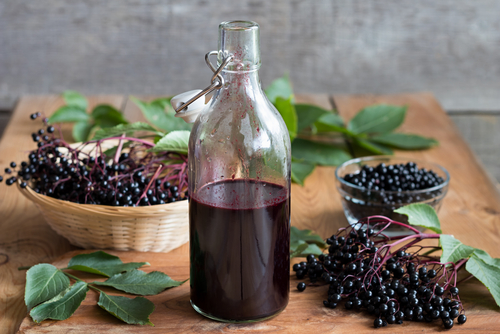
Elderberry – Immune-Boosting Berries of the Flu
When winter colds and flu struck, many Native American tribes turned to the elderberry bush for relief. The American Black Elder (Sambucus canadensis), common in much of North America, was a veritable pharmacy: the Cherokee, for example, used the berries, flowers, and even roots of elderberry to treat fever, congestion, and diarrhea.18 A tea of elder flowers was given to sweat out fevers and soothe coughs, while elderberry syrup was (and still is) cherished as a remedy for colds. The Muscogee (Creek) and Seminole were also known to use elderberry – one traditional method was to blow a medicinal powder (sometimes containing elderberry) through a tube into the patient’s body as a kind of inhalant treatment!36 Among the Pueblo peoples, elderberry was considered so therapeutic that it featured in healing rituals (some stories speak of elders using the hollow elder stems as flutes or blowpipes to “blow away” illness).36 Elderberries are packed with vitamins (A and C) and antioxidants, making them a valuable food as well as medicine. In survival situations, ripe elderberries can be a crucial source of nutrition and immune support – you can eat them cooked or dried, or boil them into a syrup to extend their shelf-life. Many modern preppers know of elderberry syrup as a flu-season staple: it can reduce the severity and duration of viral infections by supporting the immune system’s response. If you’re off-grid and catch a nasty cold, a simple elderberry decoction might help you bounce back faster. Even the act of gathering these dark purple berries and making a rustic tea or jam can lift morale. Elderberry truly bridges food and medicine, which is exactly how indigenous peoples viewed so many of their plants.
Identification:
Elderberry is typically a large shrub or small tree, often found in moist areas like stream banks, woodland edges, and swampy thickets. American elder (S. canadensis) can grow 5–12 feet high. Key features include its compound leaves – elderberry leaves are pinnate, meaning each leaf is divided into 5-11 leaflets arranged opposite each other on a central stem, with an odd terminal leaflet. The leaflets are 2–4 inches long with serrated margins and sometimes a slightly foul odor when crushed. In early summer, elderberry sports clusters of tiny white or cream-colored flowers in broad, flat-topped umbels (kind of like Queen Anne’s lace but on a woody shrub). These fragrant flower clusters can be as large as 6 inches across. By late summer (around August to September), the flowers give way to bunches of small dark purple-black berries. The berries are round, about 1/8 inch in diameter, and hang in drooping clusters (they may weigh down the branch). Important: The berries must be dark purple or nearly black and soft when ripe – unripe (green or light-colored) berries are not safe to eat. There are other species: for instance, Red Elderberry (Sambucus racemosa) in cooler climates has red berries that are considered less palatable (and potentially upsetting if eaten raw), but even those were used medicinally by some tribes (usually cooked). To be safe, stick with the common black elderberries for consumption. Elderberry bushes often form colonies by suckering, so if you find one, there are likely more. They lose leaves in winter, but their soft pithy stems and warty bumps where leaves were attached can still give them away.
Warnings:
Never eat elderberry parts raw or unripe. The unripe berries, seeds, leaves, and bark contain cyanide-producing compounds (glycosides) that can cause nausea, vomiting, and diarrhea.37 Even ripe berries have a bit of this, but cooking or drying neutralizes the toxin.38 39 So, always cook elderberries (simmer them into a syrup, pie, or tea) before consuming; this releases the cyanide as harmless vapor. If you pop a handful of raw berries in your mouth, you could get a nasty stomach ache. The symptoms of mild elderberry poisoning are basically a bad tummy flu – not something you want in a survival scenario – so take this warning seriously. Also note that Red elderberries (bright red berries, usually in mountainous or northern areas) are higher in those toxins; indigenous peoples would cook them thoroughly and even strain off the seeds. If you’re not sure of the species, it’s another reason to cook first or avoid. Pregnancy and children: There isn’t a lot of data on elderberry use in pregnancy, so while a little elderberry tea for a cold is likely fine, it’s best to use sparingly if you’re pregnant or breastfeeding. For children, elderberry syrups are popular for colds, but again ensure it’s properly cooked and sweetened (and obviously no alcohol tinctures for kids). One more caution: birds love elderberries and will often leave purple droppings – so if you see purple bird poop, you know elderberry is around! Jokes aside, just be mindful when foraging that you’re not in a polluted area (the shrub can accumulate toxins from soil). Properly prepared, elderberries are a delicious medicine – just respect the rule to cook before consuming.37
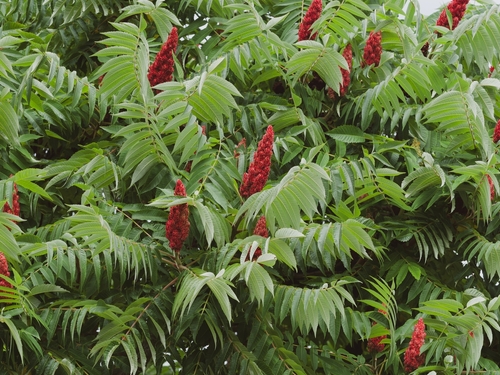
Sumac – The Versatile Wild Medicine Chest
Sumac is proof that a common “weed” can be a goldmine for survival medicine. Those bright red cone-shaped berry clusters you see on sumac in late summer aren’t just for making “wild lemonade” – they were a key medicinal resource for Native Americans. In fact, sumac was viewed as a sacred plant by some tribes.40 The Cherokee and others used smooth sumac and staghorn sumac in a variety of remedies. A decoction (strong tea) of sumac bark or root was used to treat diarrhea and dysentery, and also gargled to soothe sore throats.41 Because sumac is astringent (it tightens tissues), it helped curb inflammation and excess mucus. Sumac was one of the few herbs used for eye inflammations – some tribes made a mild wash to relieve red, irritated eyes.42 The leaves and berries together were brewed to reduce fever, and a poultice of sumac was applied to poison ivy rashes to ease the itching.43 The Comanche even used a berry tea as a gargle for throat inflammation.44 Early American doctors adopted sumac for treating mouth sores and gum disease (chewing on the berries or leaves can toughen gums). Truly, almost every part of the sumac had a use: roots for urinary problems and bleeding, bark for antiseptic washes, berries for vitamin C drinks and digestive aid, leaves for poultices. In a survival context, this means sumac can serve as a multi-purpose remedy. Have a mouth ulcer or bleeding gums? Chew a young sumac twig or make a leaf tea to use as a mouthwash. Suffering diarrhea from questionable water? A strong sumac-root tea might help tighten up your gut. Feverish and dehydrated? A tart sumac “lemonade” can lower fever and provide vitamin C. Sumac berries are also one of the easiest wild beverages – soaking a bunch in cold water yields a refreshing tangy drink loaded with antioxidants. For anyone living off the land, sumac is like a wild pharmacy and refreshment station in one.
Identification:
Several species of sumac grow throughout North America, most famously Staghorn Sumac (Rhus typhina) in the East/Midwest and Smooth Sumac (Rhus glabra). These are shrubs or small trees, often forming colonies via root suckers on sunny hillsides, edges of fields, and roadsides. In summer, sumac is unmistakable: look for the upright cone of fuzzy red berries at the tip of branches.45 Staghorn sumac’s berry clusters are dense, conical and bright crimson red (the berries themselves are coated in fine red hairs). The clusters can be 4–8 inches tall. Sumac leaves are pinnate (like elderberry, composed of many leaflets) but much longer – a single sumac leaf can be 1–2 feet long with 9–31 pointed leaflets arranged in pairs and one leaflet at the tip. In late summer and fall, the foliage turns brilliant shades of red, orange, or burgundy. The young branches of staghorn sumac are hairy (hence “staghorn,” like the velvet on a deer’s antlers), whereas smooth sumac has hairless, smooth twigs. Habitat: Sumac loves disturbed, open areas with dry to medium soil. You’ll find thickets of it alongside country roads, fences, or the slopes of clearings. It often grows in clumps, so one bright red cone may signal dozens more nearby. Sumac berries are usually ripe by late summer and can hang on through winter (though they get brownish and less tangy with time). One absolutely critical ID tip: Do not confuse edible sumacs with Poison Sumac (Toxicodendron vernix). Poison sumac is an unrelated plant that causes rash like poison ivy. Thankfully, they are easy to tell apart: Poison sumac has white or grayish berries that hang in loose drooping clusters and it grows only in swamps/boggy areas, typically as a somewhat lanky tree with 7–13 smooth-edged leaflets.45 46 Edible sumacs (Rhus genus) have red upright berry clusters and serrated leaflets, and prefer drier uplands.45 Remember this rhyme: “Red sumac sour, white sumac beware.” If the berries are red and tart, you likely have the safe sumac. If they’re white, stay away – poison sumac is far more virulent than poison ivy.
Warnings:
Sumac berries and leaves are generally safe when used in normal amounts, but a few points to consider. First, if you have severe allergies to cashews or mangoes, be cautious with sumac; they are in the same family (Anacardiaceae). While consuming sumac is not the same as touching poison ivy, very sensitive individuals should test slowly. When making sumac drinks, strain the liquid through a fine cloth – the berry hairs can be irritating to the throat if swallowed (and bugs/dirt often collect on the clusters). Sumac is quite astringent, so large quantities might cause constipation; that can be useful if you have diarrhea, but don’t overdo it if you don’t need that effect. As mentioned above, ensure you avoid poison sumac – know your habitat and berry color.46 Sumac should not be used as a sole treatment for serious illness – it’s supportive, not a miracle cure. Finally, the usual herbal caution for pregnant women: while culinary use of sumac (like as a spice or occasional drink) is fine, medicinal use of sumac (strong decoctions, etc.) in pregnancy should be done only if clearly needed, as sumac can influence the uterus (some herbalists have used it to tone the uterus or even to assist labor in the past). In general, though, sumac is one of the more benign wild remedies. Even children often enjoy the “pink lemonade” from sumac berries (just make sure it’s properly identified and filtered). When fall comes and you see those red drupes lighting up the hillside, you can appreciate that this beautiful plant also offers antiseptic, vitamin-rich medicine at your fingertips – a generous gift of nature that Native Americans were wise to use daily.47
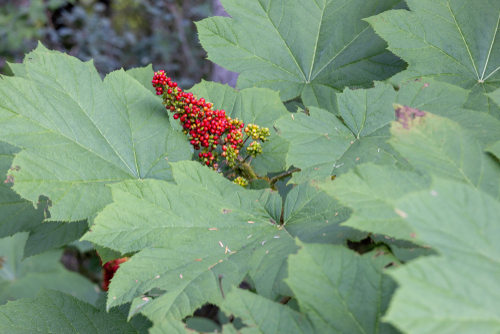
Devil’s Club – The Spiny Healer of the Northwest
In the misty forests of the Pacific Northwest lurks a formidable plant known as Devil’s Club (Oplopanax horridus). To the uninitiated, it’s a giant thorn-covered shrub that can turn a hiking trail into a pincushion. But to the indigenous peoples of Alaska, coastal British Columbia, and the Pacific Northwest, Devil’s Club has long been a revered survival medicine – so much so that there are over 38 Native names for it across different languages.48 The Tlingit, Haida, Tsimshian, Salish, and many other tribes regarded devil’s club as a cure-all. It’s sometimes nicknamed “Alaskan ginseng” for its broad healing reputation (though it’s not a true ginseng). Traditional uses read like an herbal pharmacy: the inner bark of devil’s club was made into a decoction or tea for coughs, colds, chest infections, tuberculosis, fever, and digestive problems, and as a general tonic.49 It was given in small doses to ease arthritis and rheumatism pain, and also to stabilize blood sugar in diabetics (modern research confirms it has hypoglycemic effects).50 Externally, the bark was chewed and then applied as a poultice to infected wounds, sores, and swelling – acting as an antiseptic and analgesic to numb pain. One ethnohistorical source notes that mashed devil’s club cambium was even used as an emergency bandage on cuts and burns to prevent infection and pain.53 In spiritual medicine, some communities carried devil’s club sticks or burned it to ward off evil spirits and bad luck.51 52 The plant’s very presence commands respect; perhaps that’s part of its power. For a survivor in the Northwest, devil’s club can be a boon – if you can get past the spines. In effect, devil’s club is a potent herbal antibiotic, antifungal, and anti-inflammatory. A tincture or tea from its inner bark might help you fight off a severe flu or respiratory infection when you’re days from civilization. Washing a nasty wound with devil’s club decoction could prevent it from festering. Even for pain relief – chewing a bit of root can numb a toothache or arthritic joint. This plant is so strong that many herbalists consider it “all-healing” (in fact, a 19th-century writer called it “panax horridum”, panax meaning panacea).54 Handle it carefully and it will handle what ails you.
Identification:
Devil’s club is found only in the Pacific Northwest coastal forests and some parts of the inland Northwest/Great Lakes. It favors wet, dark, old-growth forests, often near streams or swampy ground. It grows in dense thickets. The plant itself is a deciduous shrub, 3 to 9 feet tall, with a few thick stems that branch sparsely.55 56 The most striking features: the stems (and the underside of leaves) are covered in sharp, yellowish spines up to 1/2 inch long.57 These spines are no joke – they will pierce skin easily and break off. The leaves are huge and look like something tropical: they are large, palmate leaves up to 14 inches across, with 7–9 lobes, resembling a giant maple leaf in shape.58 59 The leaves have spines on the veins underneath. In late spring, devil’s club produces clusters of small whitish-green flowers on a spike (like a tall cone or raceme). By late summer, those flowers turn into a cluster of bright red berries – arranged somewhat pyramidally. The berries look tempting but are not edible for humans (birds eat them, but they can cause vomiting in people).60 In winter, the shrub is bare and the devilish spines on naked sticks make it even creepier. Devil’s club often grows intermixed with skunk cabbage and ferns in its native range. If you’re in Southeast Alaska, Western BC, coastal Washington/Oregon or even parts of Idaho/Montana in wet forests, you’ll know it when you see it – a wall of spiny club-like stems with giant leaves that say “Don’t touch!” Once you’re familiar, it has no close lookalike except maybe young maple saplings or thimbleberry. Thimbleberry, however, has soft velvety leaves and no spines (and edible red berries). Rule of thumb: If it’s a big maple-like leaf on a spiny stem in deep shade, it’s devil’s club.
Warnings:
Devil’s club demands caution both in harvest and use. Physically, beware the spines – they can easily puncture skin, become embedded, and lead to infection. Always wear gloves and use a knife to peel bark rather than grabbing the plant. If you do get pricked, clean the wound thoroughly; some say the root bark can even be used to prevent infection from its own spines. Consumption warnings: The red berries of devil’s club should not be eaten – they are considered slightly toxic (and at any rate, they taste bad).61 Stick to using the inner bark of the stems or roots for preparations. If you take devil’s club internally, do it in small, respected doses; too much can cause nausea or vomiting (it was traditionally used as a purgative in high doses).50 There are no well-documented “overdose” cases, but indigenous wisdom suggests moderation. Pregnant or breastfeeding women are advised to avoid devil’s club, as its safety hasn’t been established (and some related plants can affect uterine muscles).62 If you have diabetes and are on medication, be aware that devil’s club can lower blood sugar – monitor yourself to avoid hypoglycemia. Another consideration: harvesting devil’s club in national parks or certain Native lands may be forbidden or require a permit, as it’s culturally important – be mindful of where you are and harvest sustainably (never take the whole stand; just a portion of bark from one stem, etc.). Devil’s club is not a casual “tea herb” – it’s more of an emergency or serious-condition medicine. That said, when you need it, it can shine. Always do your research and ideally consult knowledge keepers if you plan to use this plant; it carries a strong spirit in Native lore, and disrespecting it (e.g., uprooting whole plants carelessly) is believed to dull its power. Whether or not you hold such beliefs, it’s true that overharvesting could wipe out local patches (it’s slow-growing). Use gratitude and restraint. If you do, devil’s club might just repay you by clubbing your worst ailments into submission when no pharmacy is around.

Conclusion: Ancient Wisdom for Modern Survival
These eight plants – Yarrow, Willow, Pine, Sage, Echinacea, Elderberry, Sumac, and Devil’s Club – are testament to the ingenuity and deep knowledge of Native American cultures. Long before pharmacies and hospitals, the first peoples of North America were their own doctors, using the living pharmacy around them. In their hands, a humble wildflower could stop life-threatening bleeding, a tree bark could ease agony, and a berry could guard against winter’s illnesses. In our modern world, we often overlook these “backyard remedies,” but for a prepper or wilderness explorer, this knowledge is pure gold. Learning to identify and use these plants can empower you to handle common medical issues when you’re off-grid or the grid goes down. Equally important, this knowledge connects us to the land in a respectful, reciprocal way – remember that many of these remedies come with traditions of saying thanks to the plant, harvesting sustainably, and understanding that misuse can be dangerous. Start building your own experience with plant medicine before an emergency strikes.
>>Always carry a field guide and double-check identities – never assume, for safety’s sake.
In a crisis, you’ll have options beyond what’s in your first aid kit, and that flexibility could save a life. Knowledge is the ultimate survival tool, and you’ve just added some powerful items to your mental bug-out bag. Now, the next step is yours: get outside, meet these plants in person, and maybe stock up on or grow a few of them. Your ancestors (and the ancestors of this land) did exactly that, and it sustained them through tough times. With a bit of effort, you can ensure that the old ways live on, and that you and your family stay healthy when modern medicine is nowhere to be found.63
Read the full article here









